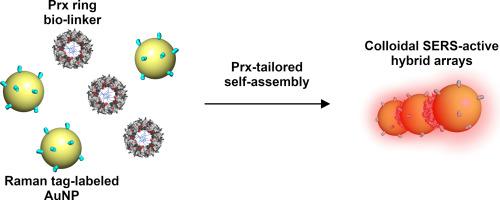当前位置:
X-MOL 学术
›
BBA Gen. Subj.
›
论文详情
Our official English website, www.x-mol.net, welcomes your
feedback! (Note: you will need to create a separate account there.)
A ring-shaped protein clusters gold nanoparticles acting as molecular scaffold for plasmonic surfaces.
Biochimica et Biophysica Acta (BBA) - General Subjects ( IF 2.8 ) Pub Date : 2020-04-15 , DOI: 10.1016/j.bbagen.2020.129617 Matteo Ardini 1 , Jian-An Huang 2 , Valeria Caprettini 2 , Francesco De Angelis 2 , Francesca Fata 1 , Ilaria Silvestri 1 , Annamaria Cimini 1 , Francesco Giansanti 1 , Francesco Angelucci 1 , Rodolfo Ippoliti 1
Biochimica et Biophysica Acta (BBA) - General Subjects ( IF 2.8 ) Pub Date : 2020-04-15 , DOI: 10.1016/j.bbagen.2020.129617 Matteo Ardini 1 , Jian-An Huang 2 , Valeria Caprettini 2 , Francesco De Angelis 2 , Francesca Fata 1 , Ilaria Silvestri 1 , Annamaria Cimini 1 , Francesco Giansanti 1 , Francesco Angelucci 1 , Rodolfo Ippoliti 1
Affiliation

|
BACKGROUND
Proteins are efficient supramolecular scaffolds to drive self-assembly of nanomaterials into regular colloidal structures suitable for several purposes, including cell imaging and drug delivery. Proteins, in particular, can bind to gold nanoparticles (AuNPs) through van der Waals and electrostatic forces as well as coordination and hydrogen bonds leading their assembly into responsive nanostructures.
METHODS
Bioconjugation of alkyne Raman tag-labeled 20 nm AuNPs with the ring-shaped protein Peroxiredoxin (Prx), characterized by a symmetric homo-oligomeric circular arrangement, has been investigated by absorption spectroscopy, transmission and scanning electron microscopy. The plasmonic behavior of the resulting hybrid assemblies has been assessed by Surface Enhanced Raman Scattering (SERS).
RESULTS
The ring-shaped Prx molecules are demonstrated to adsorb onto the gold surface acting as "sticky" bio-linkers between adjacent nanoparticles to drive self-assembly into small colloidal AuNPs arrays. The arrays show nanometric interparticle gaps tailored by the protein ring thickness. The arrays exhibit improved optical activity due to SERS allowing detection of the Raman signals from both the protein and alkyne molecules.
CONCLUSIONS
This method can be used to build up SERS-active nanostructures using Prx as both a bio-linker and platform for attaching dyes, two-dimensional materials, such as graphene, and other biomolecules including DNA and enzymes.
GENERAL SIGNIFICANCE
The development of colloidal SERS nanostructures is considered a significant step forward in spectroscopic bioanalysis. Though protein-tailored nanofabrication is in a childhood stage, these results demonstrate the versatility of supramolecular proteins as tools to build-up nanostructures which are still impractical to obtain through top-down techniques.
中文翻译:

环形蛋白质将金纳米粒子簇集起来,用作等离子表面的分子支架。
背景技术蛋白质是有效的超分子支架,以驱动纳米材料的自组装成适合于多种目的的规则胶体结构,包括细胞成像和药物递送。尤其是蛋白质,可以通过范德华力和静电力以及配位和氢键与金纳米颗粒(AuNP)结合,从而将它们组装成响应性的纳米结构。方法已通过吸收光谱,透射和扫描电子显微镜研究了炔烃拉曼标签标记的20 nm AuNPs与环状蛋白Peroxiredoxin(Prx)的生物共轭,该蛋白具有对称的均聚物-低聚环状排列。已通过表面增强拉曼散射(SERS)评估了所得混合组件的等离子体行为。结果表明,环形Prx分子吸附在金表面上,充当相邻纳米颗粒之间的“粘性”生物接头,从而驱动自组装成小的胶体AuNPs阵列。阵列显示出由蛋白环厚度定制的纳米级颗粒间间隙。由于SERS允许检测来自蛋白质和炔烃分子的拉曼信号,因此阵列具有改善的光学活性。结论该方法可用于通过使用Prx作为生物连接剂和平台来建立SERS活性纳米结构,以连接染料,二维材料(例如石墨烯)和其他生物分子(包括DNA和酶)。一般意义胶体SERS纳米结构的发展被认为是光谱生物分析中的重要一步。
更新日期:2020-04-15
中文翻译:

环形蛋白质将金纳米粒子簇集起来,用作等离子表面的分子支架。
背景技术蛋白质是有效的超分子支架,以驱动纳米材料的自组装成适合于多种目的的规则胶体结构,包括细胞成像和药物递送。尤其是蛋白质,可以通过范德华力和静电力以及配位和氢键与金纳米颗粒(AuNP)结合,从而将它们组装成响应性的纳米结构。方法已通过吸收光谱,透射和扫描电子显微镜研究了炔烃拉曼标签标记的20 nm AuNPs与环状蛋白Peroxiredoxin(Prx)的生物共轭,该蛋白具有对称的均聚物-低聚环状排列。已通过表面增强拉曼散射(SERS)评估了所得混合组件的等离子体行为。结果表明,环形Prx分子吸附在金表面上,充当相邻纳米颗粒之间的“粘性”生物接头,从而驱动自组装成小的胶体AuNPs阵列。阵列显示出由蛋白环厚度定制的纳米级颗粒间间隙。由于SERS允许检测来自蛋白质和炔烃分子的拉曼信号,因此阵列具有改善的光学活性。结论该方法可用于通过使用Prx作为生物连接剂和平台来建立SERS活性纳米结构,以连接染料,二维材料(例如石墨烯)和其他生物分子(包括DNA和酶)。一般意义胶体SERS纳米结构的发展被认为是光谱生物分析中的重要一步。











































 京公网安备 11010802027423号
京公网安备 11010802027423号